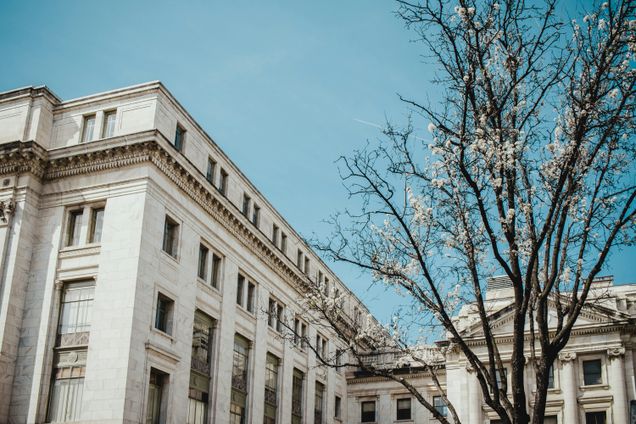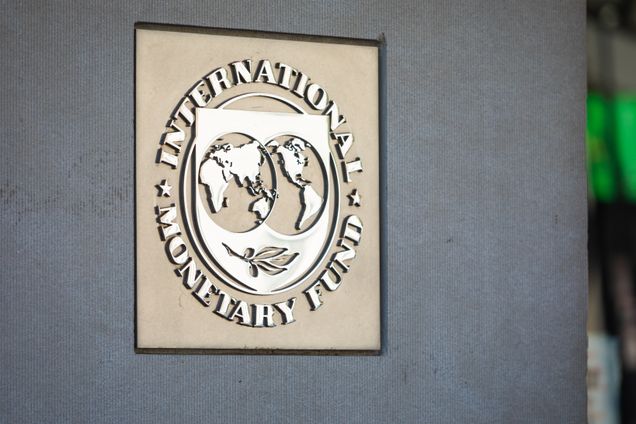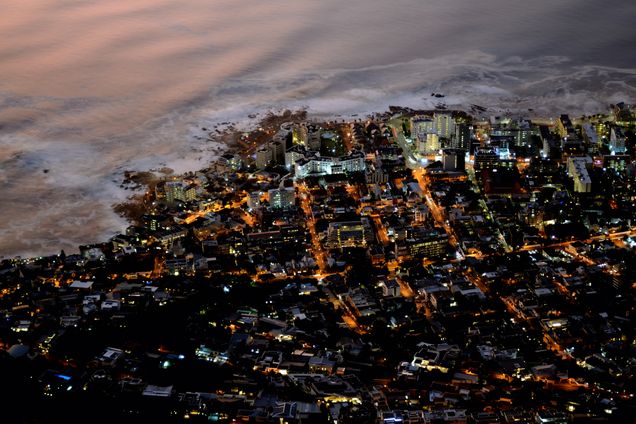GDP Center Roundup: IMF/World Bank Group Spring Meetings, 2024

From April 15-19, policymakers, civil society, researchers and more will gather in Washington, D.C. for the 2024 International Monetary Fund (IMF)/World Bank Group Spring Meetings. These official, high-level meetings will set the direction for the institutions, amid a plethora of panels and side events, as well as related meetings like the G20 Finance Ministers and Central Bank Governors’ meetings and a follow up meeting for the Coal Transition Accelerator launched at the last UN Climate Change Conference (COP28). The meetings will have significant influence on the trajectory of global issues including debt, the role of developing countries in global governance and the New Collective Quantified Goal (NCQG), the new climate finance target to be set at this year’s United Nations climate negotiations.
Three key trends will shape the Spring Meetings:
First, countries have faced a challenging few years, and the economic outlook still is not conducive to achieving shared climate and development goals, despite just six years remaining to the critical 2030 milestone. COVID-19 brought tens of millions of deaths and a shock to the global economy, with global extreme poverty rising for the first time in decades. These continued aftershocks are compounded by rising interest rates, food prices that have stretched developing economies and mounting climate shocks that are impacting all countries, but most especially the poorest and most vulnerable. These economic stressors are then reflected back in sovereign debt that has grown to twice the size of 2008 levels, with 3.3 billion people now living in countries that pay more servicing debts than on health or education.
Second, both institutions are evolving. The World Bank launched its evolution process in 2022, seeking to operate more efficiently and better promote global public goods like climate action and pandemic prevention. The IMF has also incorporated climate change into its work, adopting its first climate strategy in 2021 and launching the Resilience and Sustainability Trust, a climate-focused lending tool, in 2022. However, while these are welcome steps, the Fund’s climate work to date relies on a one-size-fits-all approach focused on carbon pricing, when bolder and greater leadership is needed. There is one thing that will stay the same at the IMF: Managing Director Kristalina Georgieva’s term is nearing completion but is the only nominee for the position, with her second term to be officially confirmed by the end of the month.
Third, the institutions will have to step up their level of ambition. Already, the important but easier reforms, like the World Bank’s initial efforts to stretch its balance sheet, have been implemented. Now, at the Spring Meetings, attention will turn to other measures for the World Bank to add to its firepower, like callable capital, hybrid capital and the replenishment of the International Development Association (IDA), as well as the framework for financial incentives to guide the allocation of resources devoted to promoting global public goods.
The IMF is under particular scrutiny following a missed opportunity to increase voice and representation in its governance system in the recent 16th General Review of Quotas. Members now face a June 2025 deadline to make progress on quota reform, while calls continue for the IMF to review its surcharge policy. And with the global sovereign debt architecture struggling, multilateral institutions and their members must confront debt relief, including their own role in it. Politicians may be hesitant to act on these issues with elections in store for half the world’s population in 2024, but there is no time to spare as progress towards the United Nations 2030 Sustainable Development Goals (SDGs) and Paris Agreement goals falls off track.
The Boston University Global Development Policy Center has published a wide range of policy-oriented research to provide insight and direction to policymakers, researchers and academics, press and civil society advocates. Below, explore research related to integrating climate change into IMF operations, expanding and strengthening the Global Financial Safety Net (GFSN), exploring pathways to decarbonization and more:
Defaulting on Development and Climate: Debt Sustainability and the Race for the 2030 Agenda and Paris Agreement

Emerging market and developing economies (EMDEs) are facing conditions that inhibit their ability to mobilize investment for the UN 2030 Agenda for Sustainable Development and the Paris Agreement, including historic levels of external debt, higher interest rates and low growth prospects to 2030.
A new report by the Debt Relief for a Green and Inclusive Recovery (DRGR) Project performs an enhanced global external debt sustainability analysis (DSA) to estimate the extent to which EMDEs can mobilize recommended levels of external financing without jeopardizing debt sustainability.
They find that of 66 economically vulnerable EMDEs, 47 EMDEs with a total population of over 1.11 billion people will face insolvency problems in the next five years if they seek to ramp up investment to meet climate and development goals. Read the report and read the summary blog.
Early Phase-Down of Coal Plants: The Role of Development Finance Institutions

While many development finance institutions (DFIs) have pledged to halt public finance into new coal-based electricity generation, decarbonization of existing coal plants is yet to receive sufficient attention. Apart from some pilot initiatives, the direct engagement of DFIs with the decarbonization of coal plants has been limited.
What, then, are scalable methods and tools that DFIs can employ to assist countries in endeavors to transition away from coal-based power generation? And what policy recommendations can help DFIs and governments retire coal plants effectively and efficiently while ensuring a just energy transition and economic development?
A new report from the Boston University Global Development Policy Center synthesizes the discussion and key findings from a November 2023 workshop where practitioners and researchers explored options to decarbonize coal plants. Read the report and read the blog.
The International Monetary Fund, Climate Change and Development: A Preliminary Assessment

As the only international institution charged with maintaining global financial and monetary stability, the IMF has a vital role to play in ushering in a green transition that is as swift as it is just.
What actions has the IMF taken since the release of its Climate Change Strategy in August 2021 to align the institution’s efforts with a development-centered approach to combatting climate change? And is the IMF on track to help vulnerable countries achieve shared climate and development goals?
A new report from the Task Force on Climate, Development and the IMF provides an independent, preliminary assessment of the IMF’s efforts to mainstream climate change. The assessment is evaluated through the development-centered lens articulated in the Task Force’s initial strategy report and advances actionable policy recommendations for the IMF and its stakeholders. Read the report and read the blog.
Understanding the Consequences of IMF Surcharges: The Need for Reform

A lesser known, but costly, trade-off of IMF lending is that the IMF imposes significant surcharges—akin to the penalty rates imposed by banks—on countries with large borrowings from the IMF that are not paid back within a relatively short time.
A journal article in the Review of Keynesian Economics by Joseph E. Stiglitz and Kevin P. Gallagher explores the consequences of the IMF’s surcharges and issues an urgent call for reform.
The authors note that surcharges were found to worsen potential outcomes for both the borrowing country and its investors, with gains accruing to the IMF at the expense of both. The authors note that this transfer of resources to the IMF has profound consequences for the borrowing country, as it affects not just the level of poverty, health, education and overall well-being in the country in crisis, but also its potential growth. Read the journal article.
Economic and Fiscal Implications of Climate Change for Vulnerable Countries in Central America and the Caribbean

Climate vulnerable countries, such as those in Latin America and the Caribbean, are currently locked in a cycle of debt and climate: extreme weather events are driving up debt burdens, shrinking already-limited fiscal space and leading to higher costs of capital. Governments are left unable to adequately invest in adaptation measures or meet nationally determined contributions.
How can climate-vulnerable countries both respond to climate impacts and invest in climate and development goals while maintaining fiscal stability?
A recent technical paper by researchers at the United Nations Economic Commission for Latin America and the Caribbean evaluates the potential impact of climate change on economic growth and fiscal accounts for six Central American and Caribbean countries: Barbados, Dominican Republic, El Salvador, Guatemala, Honduras and Saint Lucia (CAC6). Read the technical paper and read the blog.
Reforming Bretton Woods Institutions to Achieve Climate Change and Development Goals

Countries will need to mobilize a stepwise increase in domestic resources and put in place a broad array of new policies in order to meet the targets set out under the Paris Agreement on climate change and the SDGs.
To that end, the Bretton Woods Institutions (BWI) – the IMF and World Bank Group, as well as other multilateral development banks (MDBs) – will need to play an important supporting and coordinating role in these efforts.
In a journal article published in One Earth, Kevin P. Gallagher, Rishikesh Ram Bhandary, Rebecca Ray and Luma Ramos outline the scale of the financing challenge for developing countries and offer a series of policy reform proposals at the BWIs that can help align developing economy growth trajectories with climate and development goals. Read the journal paper.
A Survey of China Within and Beyond the Bretton Woods System

China’s full integration into the Bretton Woods System (BWS) since it joined the World Trade Organization (WTO) in December 2001 raised questions about exactly how China relates to the Bretton Woods institutions and the international economic order that they support. Existing studies debate whether China is supporting the BWS institutions and the order as a ‘responsible’ member, or whether it is looking to reshape the system or even undermine and replace the BWS institutions completely.
A new working paper by Yaechan Lee, William Kring, Greg Chin and Kevin P. Gallagher provides a survey of the state of the knowledge and available data on China’s role within the BWS. It details the datasets that have been collected and published on this theme of China in the international monetary, global development finance and world trade realms. Read the working paper and read the blog.
The Global Financial Safety Net (GFSN) Tracker
![]()
The GFSN is a set of institutions and mechanisms that provide insurance against crises and financing to mitigate their impacts. It has four main elements: countries’ own international reserves; bilateral swap arrangements whereby central banks exchange currencies to provide liquidity to banking systems; regional financial arrangements (RFAs) by which countries pool resources to leverage financing in a crisis; and the IMF.
The total amount of available crisis finance resources currently stands at more than $3.5 trillion.
The Global Financial Safety Net Tracker is the first global, interactive database that measures the annual lending capacity of the IMF, RFAs, central banks and the total amount of financing to combat the COVID-19 crisis via loans from the IMF, RFAs and currency swaps. The interactive is co-produced by the Boston University Global Development Policy Center, Freie Universität Berlin and the UN Conference on Trade and Development. Explore the data and read the blog.
*
Never miss an update: Subscribe to the GDP Center Newsletter.